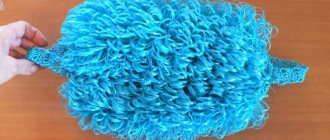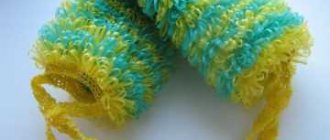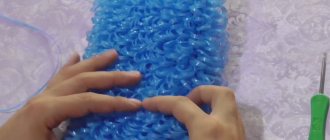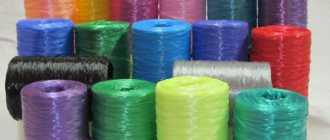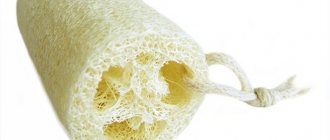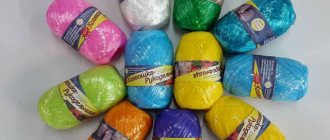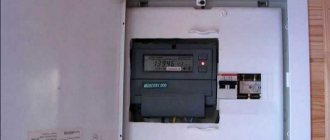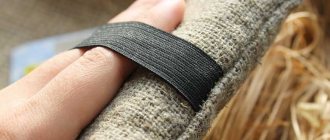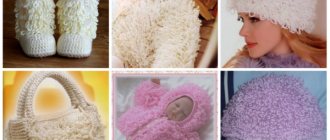Not all hand-knitted items are clothing items. You can also tie a washcloth for bathing. After all, yarn can be made not only from wool or cotton, but also from polypropylene, products from which are easy to lather and scrub off the dead skin layers well, and then wash and dry quickly. It is pleasant to wash with such a washcloth.
We will tell you how to crochet a washcloth in a variety of shapes - classic rectangular, mitten-shaped or in the form of various toys filled with foam rubber. Children will find such bathing especially enjoyable, and adults will enjoy using handmade products that are much better than store-bought washcloths.
Durable washcloth
No holes are formed in the proposed washcloth; its loops hold firmly without moving apart. The washcloth is crocheted from special threads for washcloths using crochet number 2 into one thread. The washcloth is knitted on both sides, in the round, for which 30-40 air loops are cast. The width of the washcloth depends on their number. The synthetic thread resembles polypropylene tape, but this does not interfere with crocheting at all.
Having typed the specified number of loops, we connect them into a ring with a connecting post. The next 4-5 rows are knitted with single crochet or single crochet; no pulled loops are formed on these rows. Then comes the turn of the rows with these loops, knitted in such a way that they cannot stretch and disrupt the configuration of the product.
Video lesson:
Bathing sponge
The thread that is used to create the washcloth is specifically designed for creating washcloths and rugs; it is made of polypropylene. You can choose a thread of different colors - the color range is quite wide. A carefully knitted washcloth is much more durable than a store-bought one. First of all, a chain of air loops is assembled, twice as long as the width of the future washcloth. You need to knit carefully, not allowing the thread to delaminate.
The edges of the chain are connected to each other, and a handle is immediately knitted for holding a washcloth, made of 3-4 stitches. Everything is told step by step for beginners, all actions are described in detail. After several regular rows, rows with elongated loops are knitted, which are tied around the thumb.
Video lesson:
Single layer washcloth
When knitting this washcloth, elongated loops are knitted on both sides. To obtain a more fluffy washcloth, knitting was carried out in two threads. That is, two skeins are used or one, then the second end is additionally pulled from the inside. After casting on an air row of loops, a row of stitches with one crochet is knitted.
The next row is knitted without double crochet. After the third row, we begin knitting with elongated loops, forming them with the thumb. In the last stitch of the row, a single crochet stitch is knitted. After turning the work over, the next row is knitted with similar elongated loops, and they end up on the opposite side of the product.
Choosing yarn for crocheting washcloths
Knitting is often associated with the creation of sweaters, hats, socks and other wardrobe items. They are created from wool, cotton, acrylic and yarn with various blends. Such threads are usually not suitable for knitting washcloths.
The final choice of yarn is influenced by the narrow purpose of the item. This includes cleansing, massage, facial treatment, etc. The choice of yarn for knitting a washcloth can also be influenced by the method of creation and the intended design. Typically used as yarn:
- Jute, hemp, bast. These are natural materials that are not durable. A product made from such raw materials will require careful care. Despite this, they are environmentally friendly and pleasant to the body.
- Polypropylene. A popular material for knitting washcloths. It is of artificial origin, but its characteristics are ideal for making washcloths.
- Rubber. Usually not produced in its pure form. This option allows you to create convenient rubber sponges for washing. It’s unusual to knit with such yarn, but you can make an effort to make an interesting thing.
- Acrylic and viscose. Threads are usually used for knitting typical clothing items. This option is conditionally suitable for making washcloths, but is sometimes used for this purpose.
- Nylon, nylon, polyethylene. It is rarely found on sale in its pure form. Usually the raw material acts as an additive to other fibers. Craftsmen use used nylon tights and plastic bags to knit washcloths.
Sometimes combinations of materials are used to create wash accessories. For example, it is popular to make a base made of artificial raw materials, with a surface part made of natural fibers. This product has maximum positive characteristics.
Video lesson:
Double crochet washcloth
The product is knitted in the round and has two layers. Using double crochets allows you to knit a washcloth twice as quickly and at the same time reduce thread consumption. The washcloth turns out to be soft, gentle, and quite comfortable to wash with. Threads to create the product were used in two colors, since the product is made with a gradient.
We knit with two threads using crochet number 5. 35 air loops are cast on and closed with a ring. The next row is knitted with single crochets. Then the elongated loops are knitted with a double crochet. To make the loops elongated, they are formed using the thumb. The stitches knit together very quickly. Subsequent rows are knitted similarly.
Synthetic or natural material?
Both synthetic and natural materials can be used to make washcloths. Natural materials are undoubtedly useful, but the service life of such a washcloth is about a month, since microorganisms will develop in it over time. Synthetic materials provide greater durability, the recommended period of use is up to three months.
Video lesson:
Round washcloth for bathing
The washcloth-mitten, made of threads of various colors, resembles a fancy flower. To make it neat and fluffy, we work with one thread. We start with five air loops, which are looped and after one lifting loop are knitted in a circle using single crochets. In the next row, already elongated loops are knitted between the columns of the previous row, securing them with single crochets.
After the air lifting loop, a row is formed with single crochets, increasing their number: one and two stitches are knitted into cells in turn. Then a whole row of elongated loops is knitted again. Gradually other colors are included, and in the photo the washcloth resembles a flower.
Results
If you look at examples of photos of do-it-yourself washcloths in books, brochures, craft magazines or on the Internet, you will see what a variety of these bath items there are. In addition to the original accessory, spending a minimum of time and effort, you will receive a real decoration for the bathroom, an indispensable cleanser suitable for your skin and save money.
Such washcloths can be given as a gift or an addition to a gift, or they can also be sewn for children in the form of various animals or cartoon characters. The child will be more willing to bathe with such a gift.
Video lesson:
Lush loofah
To make the washcloth look fluffy, you need to use a polypropylene thread folded in half. We begin the work with a set of thirty air loops and connect them with a ring. We knit a single crochet into each of the air loops. In the next row, single crochets alternate with single crochets. Then the same pattern is repeated.
In the next row, we knit elongated loops into each of the columns of the previous row. These loops are secured in a row consisting of single crochet stitches. The front side with elongated loops remains on the inside. The alternation of loops is repeated until the required length. Next, the washcloth is turned inside out.
Video lesson:
Crocheted washcloth
This master class is designed for those who do not know how to knit at all. The training begins with a story about how to properly hold the hook, ensuring its movement. The initial loops are also described in detail. The result is a chain of air loops, connected by a ring that serves as a cuff for the product. A row of single crochets is formed; five rows is enough.
In the next rows, elongated loops begin to form, which are draped over the thumb. The technique for creating these loops is discussed in detail on the screen. Further rows are knitted exactly the same until the washcloth reaches the specified length. You can change the color of the thread.
Master class for beginners: how to knit a fluffy washcloth
To work you will need:
- synthetic threads, better in bright colors;
- straight sp. No. 3 (select according to the thickness of the yarn).
Description
We cast on with knitting needles 30 stitches. and knit 5p. persons satin stitch
From the 6th p.m. We begin knitting elongated loops. We remove the first loop, and knit the second one like this: we hook the sp loop, as when knitting faces. satin stitch, and place the thread on top of the stitch lying on the finger.
We wrap the sp. and finger twice with yarn and knit faces. p. We knit the next p. with a regular knit stitch. Until the end of the row, we alternate knitting elongated loops and regular ones.
The master class in the photo will help you understand the technique of knitting elongated loops more clearly.
7th row: 1p. remove, the rest - persons.;
Using this pattern, we knit a washcloth of the required length.
At the end we switch to faces again. Ch. Knit 5p with this pattern.
For ropes along the edges you need to tie two strips. We cast on with knitting needles 40 sts. and knit 3p. persons satin stitch We close the loops. Sew stripes along the edges of the product.
Video lesson:
Washcloth with a pattern of “Bumps”
The yarn used is double, hook number 5. First of all, 36 chain stitches are cast on, they are connected with a ring, and a row is knitted in single crochets. In the next row, only single crochet stitches are used, then two more similar rows are knitted. Let's start creating the main pattern.
A cone is formed from three yarn overs knitted together. Two stitches are skipped, and another cone of four yarn overs is knitted. The entire row is formed from such cones. This pattern with cones is repeated from row to row. A washcloth made of cones arranged in a checkerboard pattern ends with a cuff made of rows of single crochets.
Video lesson:
Tricolor washcloth
The washcloth, painted in the colors of the Russian flag, is knitted from special yarn for washcloths. We cast on 35 loops, this number will determine the width of the washcloth. The chain of loops is closed, and you can start knitting in the round. The first rows are simple, they form the cuff of the washcloth.
Next, elongated loops of the same size begin to form in the rows, which is ensured by throwing each loop over the thumb. After knitting a third of the length of the washcloth, the color changes; another replacement of yarn is made at 2/3 of the full length of the washcloth. Before completing the knitting, two circles of simple loops are knitted to form the cuffs. Next the handle is knitted.
Video lesson:
Washcloth without elongated loops
Work begins with a set of 30 air loops. The resulting chain is looped, and two rows are knitted with single crochets. The next row is knitted with single crochets. Next, the main pattern is knitted, consisting of three double crochets, with a gap of two double crochets between them.
The result is a beautiful pattern that also closes into a ring. This three-stitch pattern is repeated on all subsequent rows until the remaining length of the washcloth is knitted. The washcloth ends, as it began, with two single crochets. The washcloth is almost complete, all that remains is to tie the handles.
Convenient crocheted accessory with long loops
To crochet a bath masterpiece you will need the following materials and tools:
- polypropylene threads;
- medium size hook (no. 4 is suitable).
Note! The hook should not have a too sharp head, as it may tear the threads.
I provide step-by-step instructions according to which you can easily knit a wonderful washcloth for your man.
1.) First part. Warp knitting. The process looks like this:
- take a skein of polypropylene thread;
- the required amount of material is unwinded;
- two strings are put together;
- a neat noose loop is made for the hook;
- a chain consisting of air loops is knitted - the thread is grabbed and pulled through the loop;
- the chain closes into a ring.
2.)Edge. Tying the ring with single crochets. The process consists of the following stages:
- The hook is inserted into the loop of the ring from front to back;
- the working thread is grabbed and pulled through the loop;
- the working thread is pulled through two loops on the hook;
- the column of the second row is knitted through the loops of the first;
- the column of the third row is knitted through the loops of the second;
- The column of the fourth row is knitted through the loops of the third.
3.) The main part of “Shaggy”. Knitting columns with double crochet. The process looks like this:
- the working thread is thrown onto the hook;
- insert the hook into the loop of the previous row;
- the working thread is grabbed from both sides so that a loop is formed on the finger;
- two threads are pulled through the loop of the row, after which the thread is thrown off the finger (four loops should form on the hook);
- the hook grabs the working thread and pulls it through the first two loops (two loops remain on the hook);
- the hook grabs the working thread and pulls it through the loops that remain;
- a row is knitted;
- the washcloth is turned inside the loops inside - for convenience;
- columns with elongated loops are knitted until the accessory is the desired length.
4.) Handles. Knitting of comfortable handles. The process looks like this:
- a single crochet is knitted into the first loop of the row;
- a chain is made from the resulting loop (the length of the chain is the length of the handle);
- several single crochets are knitted to secure the end of the chain;
- the handle is tied in the same way as the canvas, or rather its beginning;
- two or three loops are knitted in the edge of the product;
- the loop is pulled out, the knot is tightened and the thread is cut.
5.) Final stage. The accessory is turned “shaggy” outward.
That's all! The pattern is simple, but the washcloth turns out great. This bath accessory will be a great gift for your man. And if you also sew a soft towel and make fragrant soap, you will get a wonderful set for a bath. Create and delight, lovely young ladies!
